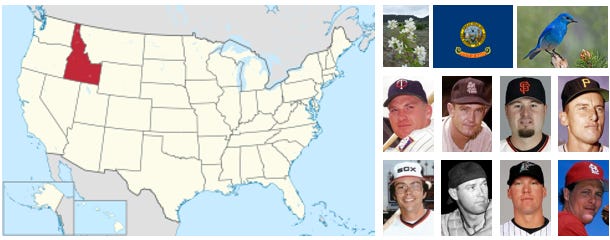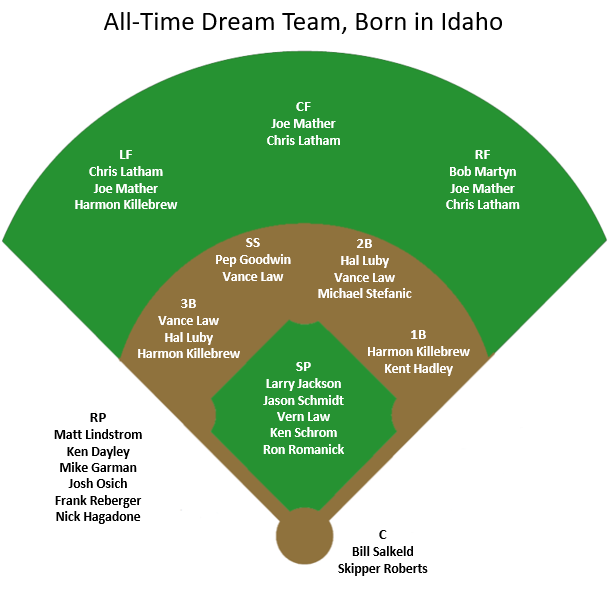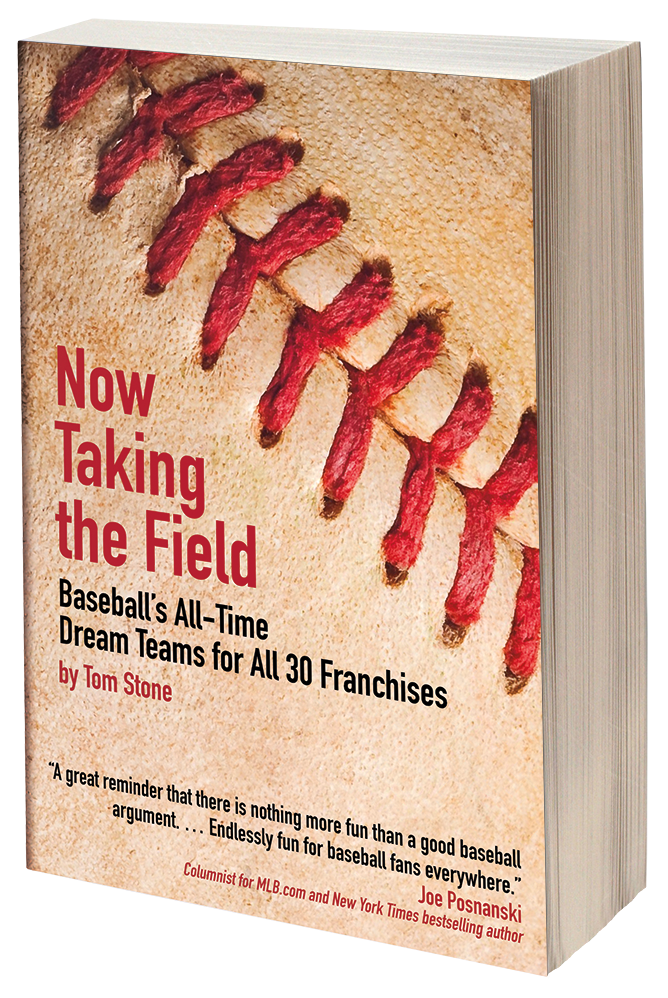Idaho's Baseball All-Time Dream Team
What would a dream team roster look like for major league players born in Idaho?
Issue #105
This is the 13th article in a series where I am creating all-time dream teams for players born in each of the fifty US states. I’ll be publishing each write-up on the anniversary date that the particular state joined the union. So far I’ve covered Maryland, Louisiana, Minnesota, South Carolina, Rhode Island, Wisconsin, Kentucky, Tennessee, Arkansas, West Virginia, New Hampshire, and Virginia.
Next up is Idaho, which became a US State on July 3, 1890, the 43rd to join the union (according to Wikipedia.)
Important caveat to what follows: I’m creating these all-time dream teams based on the birthplace data available at baseball-reference.com. I realize this might mean some players will appear for a state’s all-time dream that seems odd, e.g., a player who was born in one state but lived there only briefly, while then spending most of his youth, or especially critical years playing baseball in high school in another state. So that is an important caveat to the below dream team roster—and I’ll discuss the players that I know went to high school in a state other than Idaho towards the end of this article (and vice-versa, those born elsewhere but who went to high school in Idaho.)
Here is the all-time dream team I came up with for players born in Idaho:
Frankly, there were barely enough candidates to fill out this roster, and in the outfield in particular there were really only three—fortunately they played across all three OF positions during their short MLB careers.
That said, there is one Hall of Famer on this roster—slugger Harmon Killebrew. Born and raised in Payette, Idaho, he was an outstanding multi-sport athlete in high school. He excelled briefly in semi-pro baseball but was signed quickly by the Washington Senators in 1954, just before his 18th birthday. Because of the Bonus Rules of the time, he had to spend two years on the major league roster, which he did but was given limited playing time. He played more in the minors than the majors from 1956-58, before getting the call to stay in 1959—and promptly leading the AL with 42 HR. That would end up being the first of six AL homerun crowns for Killebrew, on his way to 573 career dingers.
Beyond Killebrew, the two next best position players born in Idaho were:
Vance Law played parts of 11 seasons, from 1980-1991, including eight years in which he played 100 or more games. The son of pitcher Vern Law, and an All-Star in 1988, he played 704 games at 3B, but was quite versatile in playing 388 at 2B, 110 at SS, 60 at 1B, and even 15 in the OF. He had 10+ HR four times, 20+ doubles six times, with a .256 average and 94 OPS+.
Bill Salkeld was a catcher for the Pirates from 1945-47 and the Boston Braves from 1948-1949. His rookie season was solid, as he hit 15 HR in 95 games with a .311/.420/.547 slash line. He never played over 80 games in a season again, but overall, he had a 128 OPS+ bolstered by a .402 OBP.
Beyond those three, the rest of the folks I included really had minimal major league careers:
1B Kent Hadley played parts of three seasons for the Kansas City Athletics and New York Yankees, from 1958-60. He had 10 HR in 1959 with a .253/.310/.403 slash line and 93 OPS+.
SS Pep Goodwin spent two years in the briefly existing Federal League (1914-15), playing for the Kansas City Packers. He had a 72 OPS+ with 1 HR and 10 SB in 193 games.
2B/3B Hal Luby was a mostly minor-league player who had a brief stint with the Philadelphia Athletics in 1936 and then most of a full season during WWII for the New York Giants (where he only batted .254 with 2 HR, but did manage a .364 OBP). He had an 84 OPS+ with 2 HR and 4 SB in 120 games.
RF Bob Martyn played parts of two seasons, 1957-58, for the Kansas City Athletics. He had an OPS+ was 94, with 3 HR in 154 games.
OF Joe Mather played parts of four seasons, 2008 and 2010 for the Cardinals, 2011 for the Braves, and 2012 for the Cubs. He had an OPS+ of only 68 with 14 HR and 7 SB in 229 games.
OF Chris Latham did quite well in the minors for many years, including regularly batting over .280 and stealing lots of bases, such as 61 in the low minors in 1994 and then 54 across A, AA, and AAA in 1995. But he had very little success in the majors while playing all three OF positions for the Twins, Blue Jays, and Yankees from 1997-203, with a 46 OPS+, a .202/.280/.277, 3 HR and 9 SB in 110 games.
C/PH Skipper Roberts played several years in the minors, but had very limited playing time in the majors in 1913 and 1914, catching in 39 games and pinch-hitting in 40 games, even though his career slash line was only .210/.253/.304 with a 60 OPS+.
2B Michael Stefanic has played a little for the Angels in 2022 and 2023, but hasn’t had much success yet after regularly hitting over .300 in the minors.
Starting lineups for this all-time dream team could look like this:
Against RHP:
Bill Salkeld C (L)
Vance Law 3B (R)
Harmon Killebrew 1B (R)
Kent Hadley 1B (L)
Bob Martyn RF (L)
Hal Luby 2B (R)
Pep Goodwin SS (R)
Joe Mather CF (R)
Chris Latham LF (S)
Against LHP:
Hal Luby 2B (R)
Vance Law 3B (R)
Harmon Killebrew 1B (R)
Joe Mather CF (R)
Kent Hadley 1B (L)
Bill Salkeld C (L)
Bob Martyn RF (L)
Pep Goodwin SS (R)
Chris Latham LF (S)
Again, Killebrew is really the only dangerous hitter here, so I slotted him third in both of these lineups. Against RHP I liked Salkeld’s .400+ OBP, and I figure Vance Law should bat near the top just based on his longer career than most of the others. Beyond that, I don’t feel strongly about the rest of how I constructed these lineups.
As for pitchers, while we don’t have any Hall of Fame caliber players here, we do have three SP who had moments of stardom. Larry Jackson was an All-Star in four seasons, three times for the Cardinals and then later, in 1963, for the Cubs. The following season he led the NL in wins with a 24-11 record, coming in second in the NL Cy Young Award vote. Overall, over 14 seasons he won 194 games and posted a 3.40 ERA and 113 ERA+.
Jason Schmidt also pitched for 14 seasons in the majors, spending time with the Braves, Pirates, Giants, and Dodgers. He was an All-Star three times with the Giants, including in 2003 when he led the NL in ERA with a 2.34 mark.
Vern Law pitched for 16 seasons for the Pirates, from 1950-67, missing 1952-53 due to military service. In 1959 he posted an 18-9 record with a 2.98 ERA, then won the NL Cy Young Award in 1960 after going 20-9 with a 3.08 ERA. Later, in 1965, he posted a career-best 2.15 ERA to go with a 17-9 record.
There weren’t many other SP candidates, so Ken Schrom (1980-87) and Ron Romanick (1984-86) get the final two spots in the five-man rotation here.
The bullpen lacked any star candidates, though there were at least several pitchers to consider. Matt Lindstrom (2007-14) spent two years as a closer, but was generally more effective as a non-closing reliever and overall posted a career 116 ERA+. Ken Dayley pitched parts of 11 seasons across 1982-1993 in the majors, ending up with a 3.64 ERA but only a 104 ERA+. Mike Garman similarly pitched parts of 9 seasons across 1969-1978 in the majors, and ended up with a 3.63 ERA and 103 ERA+.
To wrap up, several of the above players were born in Idaho but grew up and in particular went to high school in other states, including at least the following:
Ken Dayley = Oregon
Nick Hagadone = Washington
Chris Latham = Nevada
Vance Law = Utah
Joe Mather = Arizona
Ron Romanick = Washington
Jason Schmidt = Washington
What about the other direction—born elsewhere but went to high school in Idaho? I found three such players:
Leon Cadore (1915-1924) SP, born in Illinois
Josh Phelps (2000-08) DH/1B, born in Alaska
Duke Sims (1964-1974) C, born in Utah
If the dream team were based on where the players went to high school, then this already weak team would on the whole become even weaker. I’d shift Killebrew from 1B over to 3B, and have Phelps split the 1B and DH duties with Hadley. The catching position would be stronger with Sims sharing time with Salkeld, but OF would be really lacking in players. And the starting rotation would lose Schmidt and Romanick, while only gaining Cadore, and so need to elevate someone from the bullpen, such as Frank Reberger (1968-72) who started 37 of his 148 games, but only had an ERA+ of 82.
All data is from Baseball-Reference.com, and also their subscription service Stathead.com. If you are a big sports fan, be sure to check out the latest features at Stathead and the Sports Reference family of sites. The state map, flag, flower, and bird images are from Wikipedia.
Did you know? I wrote a book with the same title as this Substack newsletter / blog: Now Taking the Field: Baseball’s All-Time Dream Teams for All 30 Franchises. It was published in early 2019, by ACTA Sports, the publisher of the annual Bill James Handbook and other popular titles. You can learn more about it at www.NowTakingTheField.com, or buy directly at Amazon and other booksellers.






